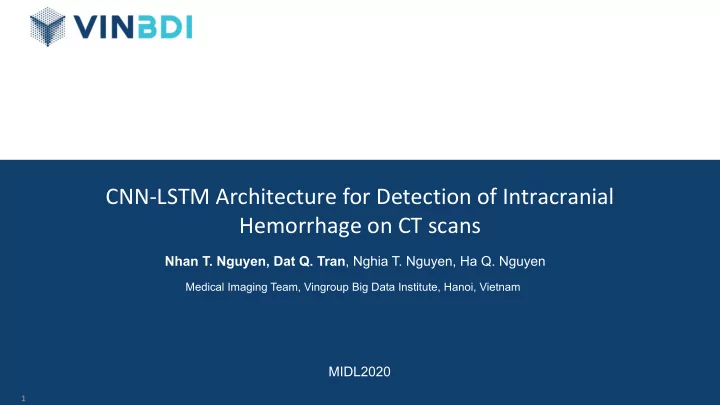

CNN-LSTM Architecture for Detection of Intracranial Hemorrhage on CT scans Nhan T. Nguyen, Dat Q. Tran , Nghia T. Nguyen, Ha Q. Nguyen Medical Imaging Team, Vingroup Big Data Institute, Hanoi, Vietnam MIDL2020 1
Motivation ● Classifying Intracranial Hemorrhage (IH) is challenging: ○ 3D representation of the data ○ Transfer learning on Imagenet ignore 3D contextual information ○ 3D CNN consume huge memory ● Efficient training strategy for 3D medical imaging: ○ Long short-term memory (LSTM) + convolutional neural network (CNN) ○ Trained end-to-end ○ Take advantage of ImageNet pretrained models ○ Modeling the spatial dependencies between adjacent slices in 3D space ● Validate the method: ○ RSNA Intracranial Hemorrhage Detection challenge ○ CQ500 dataset 2
Dataset ● RSNA dataset: ○ 25,000 non-contrast brain CT studies ○ 20 to 60 slices each ○ Manual slice-level label for 5 IH subtypes: intraparenchymal, intraventricular, subarachnoid, subdural and epidural ○ Split into a public train, a public test, and a private test ● CQ500 dataset: ○ 491 studies that has between 15 to 128 slices each ○ Manually scan-level label for 5 IH subtypes ● Windowing: ○ For each slice of the CT scan, we apply brain window (l=40, w=80), subdural window (l=75, w=215), and bony window (l=600, w=2800) and stack them to obtain the RGB-like image 3
Method ● The model consists of an CNN backbone follow by a bi-LSTM: ○ CNN extract the feature vector for each input slice ○ Feature vectors to bi-LSTM by spatial order ● Train end-to-end: 30 epochs, Adam optimizer with initial learning rate of 1e-3 and cosine annealing scheduler with linear warm-up 4
Result AUC (Area Under Curve) Finding Qure.ai ResNet-50 SE-ResNeXt-50 Intracranial 0.9419 0.9597 0.9613 Hemorrhage Models Weighted Log Loss Intraparenchymal 0.9544 0.9616 0.9674 ResNet-50 0.05289 Intraventricular 0.9310 0.9901 0.9858 SE-ResNeXt-50 0.05218 Subarachnoid 0.9574 0.9662 0.9696 Performance on private test set of RSNA Challenge Subdural 0.9521 0.9654 0.9644 These single model is on par with top 3% on Kaggle Extradural 0.9731 0.9740 0.9731 (Epidural) Performance on CQ500 in comparison with the method of Qure.ai. Thank you for your attention, VinBDI for supporting this research, and the MIDL 2020 Organisers! Source code: https://github.com/VinBDI-MedicalImagingTeam/midl2020-cnnlstm-ich Paper: https://arxiv.org/abs/2005.10992 5
Recommend
More recommend